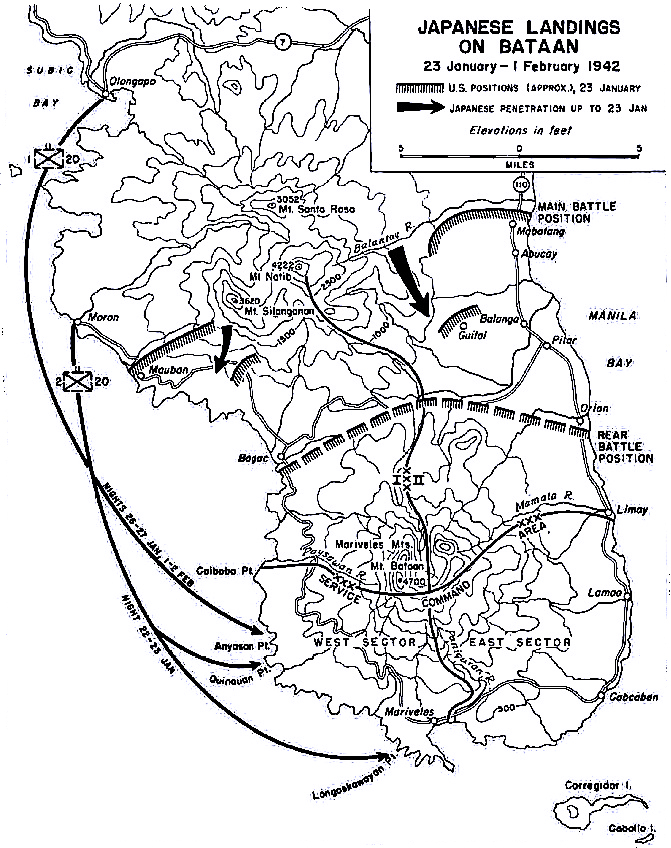INTRODUCTION
From 7 January to 9-April-1942, the Battle of Bataan was fought by the Fil-Am troops of the United States Armed Forces in the Far East (USAFFE). Said battle displayed the courage and gallantry of the Filipino from all walks of life to preserve the democratic way of life and freedom of free loving people of the world at the most intense phase of the 14th Japanese Imperial Army and Navy invasion in the Philippine Archipelago following the bombing of the US Navy base on 7-December-1941 at Pearl Harbor, Hawaii.
WAR PLAN ORANGE-3 (WPO-3)
When Gen. Douglas MacArthur returned to active duty, the latest revision plans for the defense of the Philippine Islands had been completed in April 1941 and was called WPO-3, based on the joint Army-Navy WPO of 1938 that involved hostilities between the United States and Japan. Under WPO-3, the Philippine garrison was to hold the entrance to Manila Bay and deny usage to Japanese naval forces, while ground forces were to prevent enemy landings. If the enemy prevailed, they were to withdraw to Bataan, the key to the control of Manila Bay. It was to be defended to the “last extremity.” In addition to the regular U.S. Army troops, the defenders could rely on the Philippine Army, organized and trained by Gen. MacArthur.
FIGHTING RETREAT
Gen. MacArthur intended to move his men with their equipment and supplies in good order to defensive positions. He charged the North Luzon Force led by Maj. Gen. Jonathan M Wainwright IV to hold back the main Japanese assault and keep the road to Bataan open for Maj. Gen. George Park’s South Luzon Force, which proceeded quickly and in remarkably good order, given the chaotic situation. To achieve this, Gen. Wainwright deployed his forces in a series of five defensive lines outlined in WPO-3:
D1: Aguilar to San Carlos to Urdaneta City
D2: Agno River (5th largest river in the Philippines)
D3: Santa Ignacia to Gerona to Guimba to San Jose
D4: Tarlac to Cabanatuan City
D5: Bamban to Sibul Natural Springs in Bataan
LAYAC BATAAN LINE
The main force of Gen. Masaharu Homma’s 14th Area Army landed at Lingayen Gulf on December 22 in the morning. The defenders failed to hold the beaches. By day’s end , the Japanese had secured most of their objectives and were in position to emerge onto the central plain. Facing Homma’s troops were four Filipino divisions: the 21st, 71st, 11th, and 91st, as well as a battalion of Philippine Scouts backed by a few tanks. Along Route 3 –a cobblestone road that led directly to Manila– the Japanese soon made contact with the Filipino 71st Division. American artillery action stalled the Japanese attack. However, Japanese planes and tanks routed the Filipino infantry, leaving the artillery uncovered. A second Japanese division landed at Lamon Bay, south of Manila on December 23, and advanced north.
It was evident to Gen. Wainwright he could no longer hold back the Japanese advance. On the late afternoon of the 23rd, Wainwright called MacArthur’s headquarters in Manila to report that any further defense of the Lingayen beaches was “impracticable.” He requested and was given permission to withdraw behind the Agno River. MacArthur weighed two choices: either make a firm stand on the line of the Agno River and give Wainwright his best unit, the Philippine Division, for a counterattack; or withdraw all the way to Bataan in planned stages. He decided on the latter, thus abandoning his own plan for defense and reverting to the old ORANGE plan. Having made his decision to withdraw to Bataan, MacArthur notified all force commanders on the night of December 23 stating “WPO-3 is in effect.”
PORAC-GUAGUA LINE
From January 1 to 5, 1942, as the entire USAFFE converged from south and north, delaying actions were fought to allow the struggling withdrawal to Bataan. The fiercest fighting occurred at the hastily emplaced Porac–Guagua Line, where the 11th and 21st divisions, led by U.S. Brig. Gen. William E. Brougher and Philippine Brig. Gen. Mateo Capinpin, respectively, with Col. Clinton A. Pierce’s 26th Cavalry Regiment in reserve, held the line, mostly on open and unprepared ground, against massive aerial and artillery bombardment, strong tank assaults, and infantry banzai attacks by the Takahashi and Tanaka detachments. But both sides suffered heavy casualties.
Overlooked in this report is the 23rd Infantry Regiment of the Philippine Army led by Col. Wallace A Mead. The 23rd Inf Regiment established the defensive line at Porac-Pampanga on or around 2-January-1942. Col. Mead was later awarded the Silver Star for his courageous actions. The 23rd Inf Regiment’s defense allowed Capinpin’s forces to withdraw and establish new defensive positions. It was Brig. Gen. Capinpin’s recount of the fighting on that day that was offered as support for Col. Mead’s citation.
ABUCAY–MAUBAN LINE
WPO-3 called for two defensive lines across Bataan. The first extended across the peninsula from Mauban in the west to Mabatang, Abucay in the east. Gen. Wainwright, commanding the new I Philippine Corps of 22,500 troops, held the western sector. I Corps included the Philippine Army’s 1st Regular, 31st, 91st Divisions, 26th Cavalry (Philippine Scouts), and a battery of field artillery and self-propelled guns. Gen. Parker and the new II Philippine Corps including the Philippine Army’s 11th, 21st, 41st, 51st divisions, and 57th Infantry (PS) numbering 25,000 men, defended the eastern sector. All the divisions, already under-strength at the onset of war, suffered serious combat losses, due to desertions. The U.S. Army’s Philippine Division made up of the 31st Infantry, 45th Infantry (PS), and supporting units became the “Bataan Defense Force Reserve.” Mount Natib, a 4,222-foot-high mountain that split the peninsula, served as the boundary line between the two corps. The commanders anchored their lines on the mountain, but because they assumed the rugged terrain was impassable, they did not extend their forces up to its slopes. The two corps were not in direct contact with each other, leaving a serious gap in the defense line. With the fighting withdrawal completed, the Abucay-Mauban Line, USAFFE’s main battle position was now in place.
2nd LT ALEXANDER R. NININGER
Nininger was killed in action near Abucay, Bataan on 12-January-1942. He was posthumously awarded the Medal of Honor for leading an assault on Japanese positions. He was the first American army soldier to be honored in World War II.
BATTLE OF TRAIL TWO
Within four days, the Orion-Bagac Line was formed. But the defenders had yet to complete their withdrawal to the reserve battle position when the Japanese struck again, through a gap held by the I Corps. Thus Gen. Bluemel hastily organized a defense along Trail Two, consisting of 32nd Infantry, 41st Infantry, and 51st Division reinforcements to stop a major offensive and plug the gap.
BATTLE OF THE POCKETS
The remaining Japanese troops managed to get through, however, and held out at some rear sectors of the Orion-Bagac Line at the Tuol River Valley behind the 11th Division, and in the Gogo-Cotar River behind the 1st Regular Division. From January 23 to February 17, coordinated action by the defenders to eliminate these salients of resistance became known as the “Battle of the Pockets.”
Fierce fighting ensued. Captain Alfredo M. Santos of the 1st Regular Division outmaneuvered the enemy during their attempt to pocket the area. In both attempts, his unit successfully broke through the Gogo-Cotar and Tuol pockets, thus earning himself the moniker “Hero of the Pockets.” For his successes, he was promoted to major in the field. Major Alfredo Santos was then given the hazardous mission of closing the gaps and annihilating the enemy troops that had infiltrated the lines, as the gap posed a serious threat to the positions and the total security of the division. He led a counterattack against the strong and numerically superior Japanese forces positioned between the MLR and the Regimental Reserve Line (RRL).
The fighting began at dawn on 29-January-1942, and the Americans restored the defensive sector assigned to the 1st Regular Division. On 3-February-1942, 1st Lieutenant Willibald C. Bianchi of the 45th Infantry, Philippine Scouts, led a reinforced platoon forward against two enemy machine-gun nests. He silenced them with grenades, and despite two machine gun wounds to the chest, he manned an antiaircraft machine gun until he was knocked off the tank by a third severe wound. He was awarded the Medal of Honor. Of the 2,000 Japanese soldiers, 377 escaped.
BATTLE OF THE POINTS
The naval infantry consisted of 150 ground crewmen from Patrol Wing 10, 80 sailors from the Cavite Naval Ammunition Depot; 130 sailors from USS Canopus (AS-9); 120 sailors from the base facilities at Cavite, Olongapo, and Mariveles; and 120 Marines from an antiaircraft battery. Sailors used the Canopus machine shop to fabricate makeshift mountings for machine guns salvaged from Patrol Wing 10’S damaged aircraft. The Marines were distributed through the ranks, and the sailors were told to “watch them and do as they do.” The sailors attempted to make their white uniforms more suitable for combat by dying them with coffee grounds. The result was closer to yellow than khaki. The diary of a dead Japanese officer described them as a suicide squad dressed in brightly colored uniforms and talking loudly to draw fire and reveal enemy positions.
Japanese commanders, in an attempt to hold onto their lodgements, reinforced the beachheads piecemeal, but could not break out. Battles were fought ferociously against a company-sized group at the Lapay-Longoskawayan Points from January 23 to 29, at the Quinawan-Aglaloma Points from January 22 to February 8, and at the Silalim-Anyasan Points from January 27 to February 13. Out of the 2,000 Japanese troops, only 43 wounded returned to their lines. These battles were called the “Battle of the Points.”
FALL OF BATAAN
On the night of March 12, Gen. MacArthur, his family, and several USAFFE staff officers left Corregidor for Mindanao aboard four PT boats commanded by Lieutenant Commander John D. Bulkeley. For this, and a number of other feats over the course of four months and eight days, Bulkeley was awarded the Medal of Honor, the Navy Cross, the Distinguished Service Cross, and other citations.
MacArthur was eventually flown to Australia where he broadcasted to the Filipino people his famous “I Shall Return” promise. MacArthur’s departure marked the end of the USAFFE, and by March 22, the defending army was renamed the United States Forces in the Philippines (USFIP). Lt. Gen. Jonathan Wainwright IV was placed in command.
After the failure of their first attack against Bataan at the Battle of Trail Two, Battle of the Pockets, and Battle of the Points, the Japanese general headquarters sent strong artillery forces to the Philippines in order to smash the American fortifications. They had 190 artillery pieces, which included bigger guns like 150 mm cannons and the rare Type 45 240 mm howitzer. The 1st Artillery headquarters, under Maj. Gen. Kineo Kitajima, who was a known authority on IJA artillery, moved to the Philippines along with the main forces to command and control these artillery units. Also, the Japanese high command reinforced Gen. Homma’s 14th Imperial Army, and toward the end of March, the Japanese forces prepared for the final assault.
On 3-April-1942 the entire Orion-Bagac Line was subjected to incessant bombings by 100 aircrafts and bombardment by 300 artillery weapons from 9:00 a.m. to 3:00 p.m., which turned the Mount Samat stronghold into an inferno. Over the course of the next three days (Good Friday to Easter Sunday), the Japanese 65th Brigade and 4th Division spearheaded the main attack on the left flank of the II Corps. Everywhere along the line, the American and Filipino defenders were driven back by Japanese tanks and infantry.
Based on his two prior attempts, Gen. Homma had estimated that the final offensive would require a week to breach the Orion-Bagac Line, and a month to liquidate two final defense lines he believed had been prepared on Bataan. When the opening attack required just three days, he pushed his forces on April 6 to meet expected counterattacks head-on. The Japanese launched a drive into the center, penetrated into flanks held by the 22nd and 23rd Regiments of the 21st Division, captured Mount Samat, and outflanked all of the II Corps. Counterattacks by the U.S. Army and Philippine Scout regulars held in reserve were futile; only the 57th Infantry gained any ground, but soon lost.
Along the battlefront, units of I Corps and the devastated remnants of II Corps, crumbled and moved to the rear. The commanders on Bataan lost all contact with their units, except by runners. In the last two days of defending Bataan, the entire Allied defense progressively disintegrated and collapsed, clogging all roads with refugees and fleeing troops (some were evacuated by YAG-4 from the Mariveles Naval Base, Bataan). By April 8, the senior U.S. Commander of Bataan, Maj. Gen. Edward P. King saw the futility of further resistance and set forth proposals for capitulation.
The next morning, on 9-April-1942, Maj. Gen. King met with Maj. Gen. Kameichiro Nagano and, after several hours of negotiations, the remaining weary, starving, and emaciated American and Filipino defenders on the battle-swept Bataan Peninsula finally surrendered.
Maj. Gen. Edward King discusses terms of surrender with Japanese officers at Balanga Elementary School.
Radio broadcast – Voice of Freedom – Malinta Tunnel – Corregidor – 9-April-1942: Bataan has fallen!
“The Philippine-American troops on this war-ravaged and bloodstained peninsula have laid down their arms. With heads bloody but unbowed, they have yielded to the superior force and numbers of the enemy.
The world will long remember the epic struggle that Filipino and American soldiers put up in the jungle fastness and along the rugged coast of Bataan. They have stood up uncomplaining under the constant and grueling fire of the enemy for more than three months. Besieged on land and blockaded by sea, cut off from all sources of help in the Philippines and in America, the intrepid fighters have done all that human endurance could bear.
For what sustained them through all these months of incessant battle was a force that was more than merely physical. It was the force of an unconquerable faith—something in the heart and soul that physical hardship and adversity could not destroy. It was the thought of native land and all that it holds most dear, the thought of freedom and dignity and pride in these most priceless of all our human prerogatives.
The adversary, in the pride of his power and triumph, will credit our troops with nothing less than the courage and fortitude that their own troops had shown in battle. Our men fought a brave and bitterly contested struggle. All the world will testify to the almost superhuman endurance with which they stood up until the last hour, amidst overwhelming odds.
But the decision had to come. Men fighting under the banner of unshakable faith are made of something more than flesh, but they are not made of impervious steel. The flesh must yield at last, endurance melts away, and the end of the battle must come. Bataan had fallen, but the spirit that made it stand, a beacon to all the liberty-loving people of the world, cannot fall.”
Maj. Gen. Edward A. King, Commander, I Corps. University of Georgia Class of 1902.
Jonathan M. Wainwright, West Point Class of 1906, Commander, United States Forces in the Philippines.
Maj. Gen. George M. Parker, Commander, II Corps, Shattock School, IOWA Class of 1909.
Brig. Gen. Mateo M. Capinpin, Commander, 21st Infantry Division. Rose from the rank of Corporal
Gen. Alfredo Santos, then Captain, Company Commander of the 1st Infantry Regular Division under Brig. Gen. Vicente Lim. BSCE MIT 193.
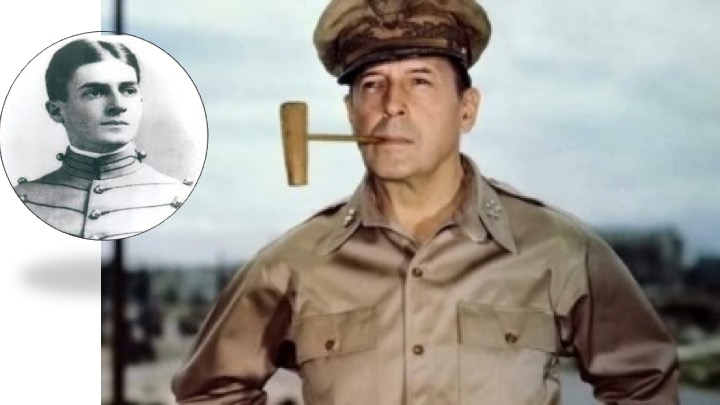
Gen. Douglas Mac Arthur, West Point Class of 1903, Commander-In-Chief of all US Forces and Filipino Forces in the Philippines.
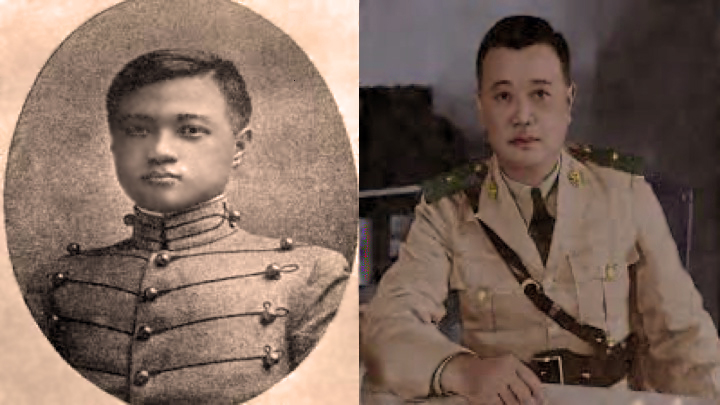
Cadet Vicente Lim, West Point Class 1914; Brigadier General Vicente Lim, Commander, 41st Infantry Division.
CONCLUSION AND AFTERMATH OF THE BATTLE
| Commanders and Leaders | |
| Douglas MacArthur Jonathan Wainwright IV George M. Parker Edward P. King Vicente Lim Mateo Capinpin |
Masaharu Homma Susumu Morioka Kineo Kitajima Kameichiro Nagano |
| Strength | |
| 120,000 U.S. and Filipino troops | 75,000 Japanese troops |
| Casualties and Losses | |
| 106,000 10,000 killed, 20,000 wounded, 76,000 captured |
8,406–22,250 3,107 killed, 230 missing, 5,069 wounded |
BATAAN TODAY
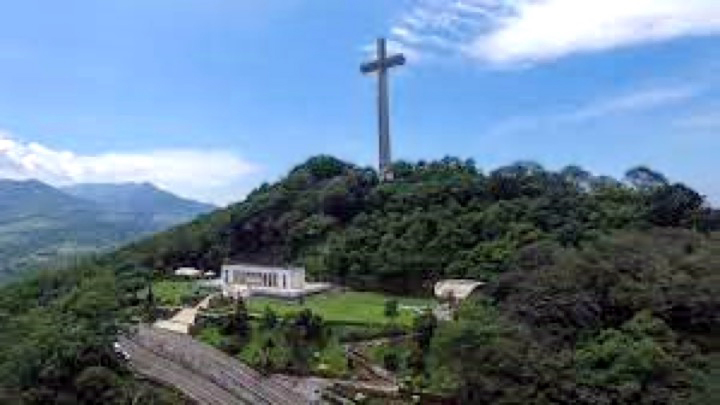
Dambana ng Kagitingan at the Peak of Mt. Samat
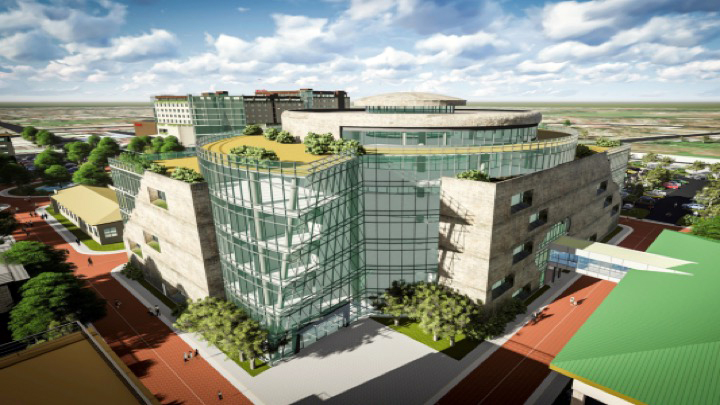
The Bunker, Balanga City Capitol Building
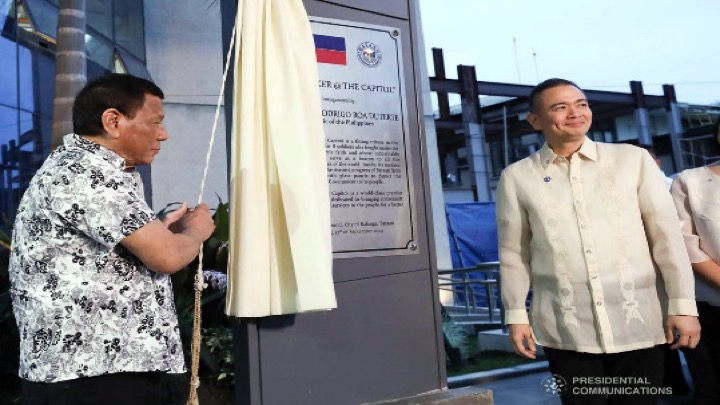
President Rodrigo Duterte unveils the marker of the Bataan Government Center and Business Hub, “The Bunker,” during its inauguration in Balanga City, Bataan on 12-September- 2019.
The bunker is a military field fortification designed to protect gun emplacement from bombs, gunfire, and artillery fire. It was constructed and built by combat engineers in the line of resistance.
Today, a bunker building constructed and inaugurated last 12-September-2019 was built under the administration of provincial governors Abet Garcia of Bataan. The provincial capitol building was designed and supervised by Architect Henry B. Mayuga, the son of Col. Leonardo A. Mayuga, a war veteran of Bataan.
Said bunker building in Balanga City symbolizes the three major battles fought and won by Fil-Am troops in the Battle of Trail Two, Battle of the Pockets, and the Battle of the Points. These victorious battles delayed the advance of the 14th Imperial Japanese Army by three months which consequently provided enough time for Gen. Douglas McArthur to regroup the allied forces in Australia.
About the Researcher
CAPT TOMAS D BAINO PN (Ret), a Civil Engineer who hails from Samal, Bataan, is a member of the Editorial Board of the Maritime Review, the journal of The Maritime League.
His early Civil Engineering career was initially spent at the Provincial Engineering Office of Bataan in 1970 before joining the Philippine Navy. He was with the Naval Construction Battalion known as the PN SEABEES involved in the early reclamation of the Cultural Center in 1973 and the construction of an Airfield in PAGASA Island, Spratly, the West Philippine Sea sometime in 1974.
He was sent by the Philippine Navy to study Combat Engineering in the Engineer Officer Advance Course at the United States Army Engineer School at Fort Leonard Wood, Missouri, USA in 1991.
References:
- Photo credit and narratives: Wikipedia
- Presidential Communications Operations Office, Malacanang
